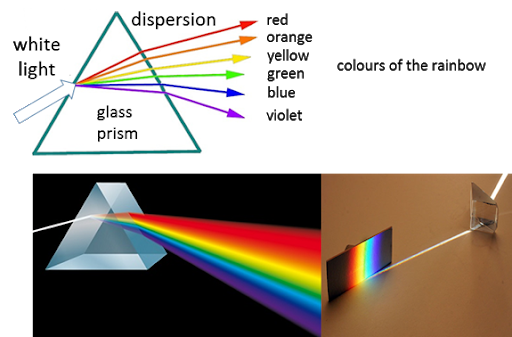
Splitting of light when it passes through prism is called as.
Answer
481.2k+ views
Hint:A rainbow is arguably the most well-known example of dispersion, in which dispersion causes the spatial separation of white light into components of different wavelengths (different colors). However, dispersion has an impact in a variety of different situations: for example, group velocity dispersion causes pulses to spread in optical fibres, diminishing messages over long distances; and soliton waves result from the cancellation of group velocity dispersion and nonlinear effects.
Complete step by step solution:
When white light passes through a glass prism, it separates into its spectrum of colours (in sequence violet, indigo, blue, green, yellow, orange, and red), a process known as dispersion.
Dispersion in a prism is the easiest method to describe dispersion.

When light moves from one medium to another, the speed at which it propagates varies, and it bends or refracts as a result. Light is now refracted towards the triangle's base as it passes through a prism. The diagram above clearly depicts the refraction of light via a prism.
The wavelengths of different colours in the spectrum of light are varied. As a result, the rate at which they bend varies depending on the wavelength, with violet bending the most due to its shortest wavelength and red bending the least due to its longest wavelength.
When white light is refracted by a prism, it disperses into its spectrum of colours as a result of this.
Light does, in fact, spread into its range of colours on a glass slab. If we look at it in a certain manner, we can see it. Before we begin, you should be familiar with refractive indices. They aren't always the same. They are affected by the frequency of light and, as a result, the wavelength.
White light is now refracted not once, but twice when it passes through a glass slab or a glass prism. It goes from the air to the glass, then back to the air. It slows down in the first occurrence of refraction and accelerates up in the second
Note:
Dispersion is a phenomenon in optics where the phase velocity of a wave is affected by its frequency. Newton was the first to experiment with light flowing through a prism. He let sunlight pass through the prism, expecting to see white light on the other side of the screen, but instead saw a spectrum of light after dispersion.
Complete step by step solution:
When white light passes through a glass prism, it separates into its spectrum of colours (in sequence violet, indigo, blue, green, yellow, orange, and red), a process known as dispersion.
Dispersion in a prism is the easiest method to describe dispersion.

When light moves from one medium to another, the speed at which it propagates varies, and it bends or refracts as a result. Light is now refracted towards the triangle's base as it passes through a prism. The diagram above clearly depicts the refraction of light via a prism.
The wavelengths of different colours in the spectrum of light are varied. As a result, the rate at which they bend varies depending on the wavelength, with violet bending the most due to its shortest wavelength and red bending the least due to its longest wavelength.
When white light is refracted by a prism, it disperses into its spectrum of colours as a result of this.
Light does, in fact, spread into its range of colours on a glass slab. If we look at it in a certain manner, we can see it. Before we begin, you should be familiar with refractive indices. They aren't always the same. They are affected by the frequency of light and, as a result, the wavelength.
White light is now refracted not once, but twice when it passes through a glass slab or a glass prism. It goes from the air to the glass, then back to the air. It slows down in the first occurrence of refraction and accelerates up in the second
Note:
Dispersion is a phenomenon in optics where the phase velocity of a wave is affected by its frequency. Newton was the first to experiment with light flowing through a prism. He let sunlight pass through the prism, expecting to see white light on the other side of the screen, but instead saw a spectrum of light after dispersion.
Recently Updated Pages
A man running at a speed 5 ms is viewed in the side class 12 physics CBSE

The number of solutions in x in 02pi for which sqrt class 12 maths CBSE

State and explain Hardy Weinbergs Principle class 12 biology CBSE

Write any two methods of preparation of phenol Give class 12 chemistry CBSE

Which of the following statements is wrong a Amnion class 12 biology CBSE

Differentiate between action potential and resting class 12 biology CBSE

Trending doubts
What are the major means of transport Explain each class 12 social science CBSE

Which are the Top 10 Largest Countries of the World?

Draw a labelled sketch of the human eye class 12 physics CBSE

Explain sex determination in humans with line diag class 12 biology CBSE

Explain sex determination in humans with the help of class 12 biology CBSE

Differentiate between homogeneous and heterogeneous class 12 chemistry CBSE




